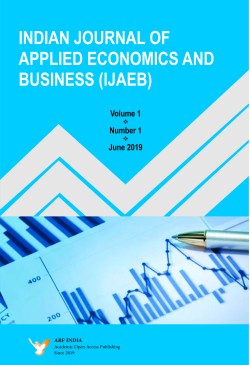
Indian Journal of Applied Economics and Business
Frequency :Bi-Annual
ISSN :2582-4325
Peer Reviewed Journal
Applying an extended IS-LM model, this study finds that fiscal expansion raises output and causes real appreciation and that monetary expansion increases output and causes real depreciation. In addition, a lower real interest rate or a higher real stock price increases output, and a lower real interest rate or a higher real stock price causes real appreciation. Therefore, except for the positiveimpact of fiscal expansion on output, the Mundell-Fleming model applies to China.
Keywords: fiscal expansion, monetary expansion, exchange rates, Mundell-Fleming model.
JEL Codes: E52, E62, F41
This study was carried out to prepare a report on the impact of the quantity demanded of chicken and its determinants. In order to identify the determinants that will impact to the quantity demand and to determine the quantity demand equation, regression analysis we used. In this analysis there are four independent variables. Therefore to incorporate all these variables multiple regression analysis adopted. To estimate the population regression function, ordinary least square method (OLS) was used. First and foremost there are 35 observations in this sample. Annual data has been collected for the quantity demand, chicken price, beef price, related good price and disposable income variables. The analysis mainly done by using Eviews statistical software and for some analysis we have used SPSS software as well. According to the correlation matrix it was found that there are strong correlations between the quantity demand and price of beef as well as the quantity demand and the disposable income. Correlation between the quantity demand and the price of chicken showed a weak correlation. Also the price of related good and quantity demand also exhibited a weak correlation.
Keywords: Quantity demanded of chicken, determinants, regression analysis, multiple regression analysis, ordinary least square method, Eviews statistical software and SPSS software.
This paper examines the long-run and short-run causal relationship among money supply, inflation and price level in India using a long series data from 1960 to 2016 using the ADF unit root test, Johansen cointegration test, Granger causality test and vector error correction method. The ADF test results show that the variables are nonstationary at levels but stationary at first difference without trend. The Johansen cointegration test shows cointegration among the variables. The Granger causality test reveals that a directional causality exists between money and output, and unidirectional causation between inflation and output. The results of cointegration test shows that there is one cointegrating equation at 5 percent level of significance, meaning that there is long-term stable relationship among the three variables - price level, output and inflation. The VECM results show short-run causality from money supply to price level. The speed of adjustment or correction of any short-run disequilibrium in money supply towards long-run equilibrium is 5.3 percent per year.
Keywords: money supply, inflation, economic growth, causality, tests, VECM, disequilibrium, adjustment.
The study determined the utilization efficiency of farm productive inputs used in sugarcane production among smallholder farmers in Kwara State of Nigeria. Farm survey data of 2017 cropping season elicited from 105 farmers structured questionnaire complemented with interview schedule were used. The sample size was drawn through multi-stage sampling techniques and the collected data were analyzed using multiple regression model estimated by ordinary least square (OLS) technique. From the results, it was observed that poor capital base caused the insufficiency in the application of agrochemicals by the farmers in the production of sugarcane in the studied area. However, there was excess use of hired labour due to the cheap mammoth available labour force in the studied area, thus affecting sugarcane production. Generally, the farmers were inefficient in the use of farm resources in the production of sugarcane as they operate in the irrational surface (stage I) with most of the important farm inputs (sucker and farm size) been under-utilized. Therefore, the study recommends that the farmers should increase the use of the aforementioned important inputs and are advised to pool their social capitals in order to take advantage of pecuniary economies, thus exploring the potentials in sugarcane production in the studied area. In addition, credit facilities and extension service delivery should be enhanced, thus increasing sugarcane production and doubling farmers’ income for sustainable and enhanced farm family livelihood in the studied area.
Keywords: Farm inputs; Allocative efficiency; Sugarcane; Farmers; Small-scale; Nigeria
Non-bank financial institutions (NBFIs) play a crucial role to resilience the economic activity through the acceleration of additional financial services besides the banking sector which helps to achieve the desired growth and development of a country. Considering the importance of NBFIs, the study attempts to examine the effects of risk levels on the performance and investigate the determinants of performance of NBFIs in Bangladesh. For the empirical analysis, the paper has been applied panel data analysis technique on collected data for the periods of 2014-2018 from 21 selected NBFIs which are listed in Dhaka Stock Exchange (DSE). The estimated results of risk index show that the selected NBFIs are safer that incurs less probability for insolvency. The results of the panel regression analysis show that the performance of NBFIs in terms of Return on Equity (ROE) and Return on Assets (ROA) is significantly influenced by the firm specific factors like risk index, total assets, squared of total assets, leverage ratio, real interest rate and the interaction between risk levels and total assets, while the macroeconomic specific factors like inflation and GDP growth rate are positively associated with the performance of NBFIs in Bangladesh.
Key Words: Non-Bank Financial Institutions, Risk Index and Probability of Insolvency, Risk and Performance, Determinants of Performance, Bangladesh.